Unit3教案
- 格式:docx
- 大小:17.87 KB
- 文档页数:4
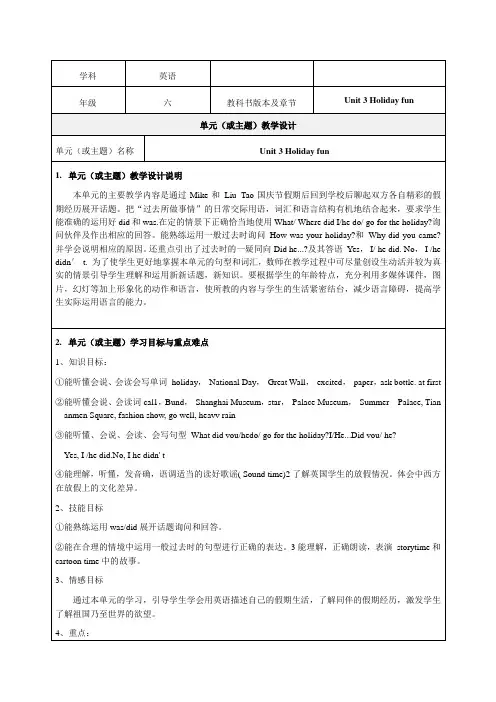
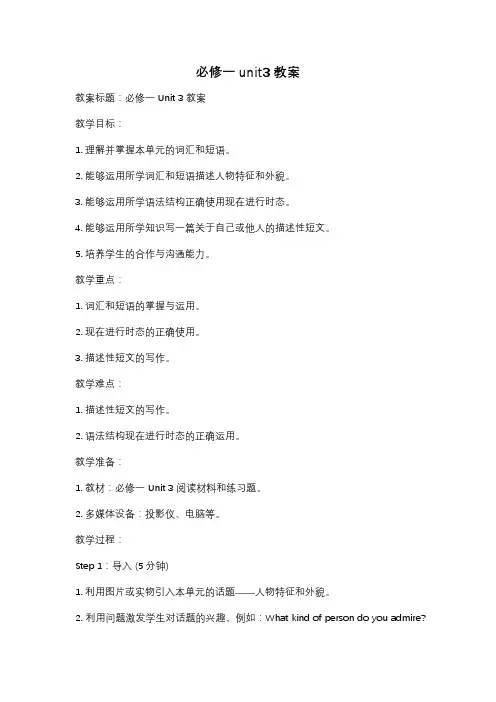
必修一unit3教案教案标题:必修一 Unit 3 教案教学目标:1. 理解并掌握本单元的词汇和短语。
2. 能够运用所学词汇和短语描述人物特征和外貌。
3. 能够运用所学语法结构正确使用现在进行时态。
4. 能够运用所学知识写一篇关于自己或他人的描述性短文。
5. 培养学生的合作与沟通能力。
教学重点:1. 词汇和短语的掌握与运用。
2. 现在进行时态的正确使用。
3. 描述性短文的写作。
教学难点:1. 描述性短文的写作。
2. 语法结构现在进行时态的正确运用。
教学准备:1. 教材:必修一 Unit 3 阅读材料和练习题。
2. 多媒体设备:投影仪、电脑等。
教学过程:Step 1:导入 (5分钟)1. 利用图片或实物引入本单元的话题——人物特征和外貌。
2. 利用问题激发学生对话题的兴趣,例如:What kind of person do you admire?Why?Step 2:词汇和短语学习 (15分钟)1. 呈现并教授本单元的词汇和短语,例如:appearance, personality, confident, determined, etc.2. 运用图片和例句帮助学生理解和记忆词汇和短语。
3. 进行词汇和短语的练习,例如:单词拼写、填空等。
Step 3:语法学习 (20分钟)1. 介绍现在进行时态的用法和构成。
2. 利用图片和例句帮助学生理解和记忆现在进行时态的用法。
3. 进行现在进行时态的练习,例如:选择填空、改错等。
Step 4:阅读理解 (15分钟)1. 学生阅读本单元的阅读材料,并回答相关问题。
2. 学生之间进行小组讨论,分享自己的理解和答案。
3. 教师进行解答和讲解,帮助学生更好地理解和掌握阅读材料。
Step 5:写作练习 (20分钟)1. 学生根据所学词汇、短语和语法结构,写一篇关于自己或他人的描述性短文。
2. 学生之间进行互相交流和修改,提供反馈和建议。
3. 部分学生展示自己的作文,进行班级评价和讨论。
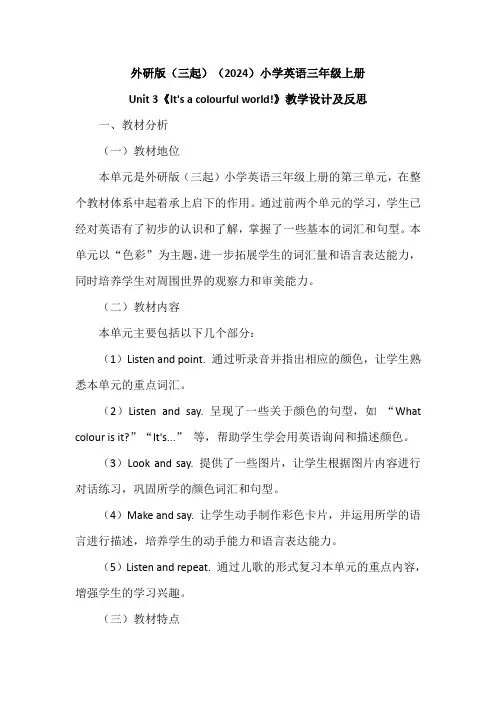
外研版(三起)(2024)小学英语三年级上册Unit 3《It's a colourful world!》教学设计及反思一、教材分析(一)教材地位本单元是外研版(三起)小学英语三年级上册的第三单元,在整个教材体系中起着承上启下的作用。
通过前两个单元的学习,学生已经对英语有了初步的认识和了解,掌握了一些基本的词汇和句型。
本单元以“色彩”为主题,进一步拓展学生的词汇量和语言表达能力,同时培养学生对周围世界的观察力和审美能力。
(二)教材内容本单元主要包括以下几个部分:(1)Listen and point. 通过听录音并指出相应的颜色,让学生熟悉本单元的重点词汇。
(2)Listen and say. 呈现了一些关于颜色的句型,如“What colour is it?”“It's...”等,帮助学生学会用英语询问和描述颜色。
(3)Look and say. 提供了一些图片,让学生根据图片内容进行对话练习,巩固所学的颜色词汇和句型。
(4)Make and say. 让学生动手制作彩色卡片,并运用所学的语言进行描述,培养学生的动手能力和语言表达能力。
(5)Listen and repeat. 通过儿歌的形式复习本单元的重点内容,增强学生的学习兴趣。
(三)教材特点(1)以学生为中心,注重培养学生的语言运用能力。
教材中的活动设计贴近学生的生活实际,让学生在真实的情境中学习和运用英语。
(2)内容丰富多样,形式活泼有趣。
教材中不仅有听、说、读、写等多种语言技能的训练,还有歌曲、游戏、手工制作等活动,激发学生的学习兴趣。
(3)注重跨学科融合。
本单元将英语学习与美术学科相结合,让学生在学习英语的同时,提高对色彩的认识和审美能力。
二、教学目标知识目标(1)能听懂、会说、认读单词:red, blue, green, yellow, orange, purple, pink, black, white。
(2)能听懂、会说句型“What colour is it?”“It's...”并能在实际情境中运用。
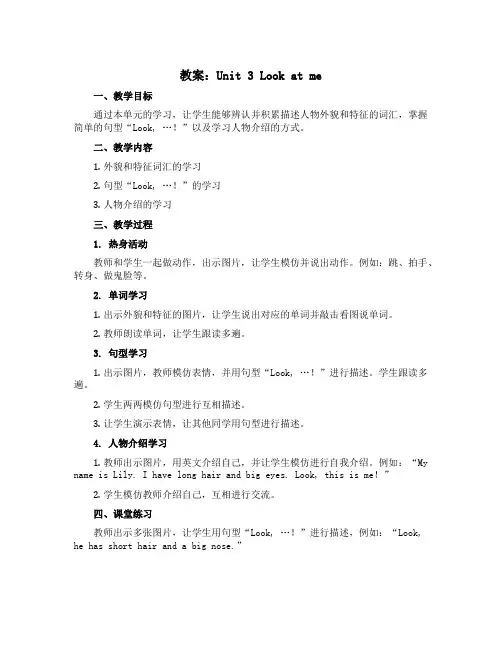
教案:Unit 3 Look at me一、教学目标通过本单元的学习,让学生能够辨认并积累描述人物外貌和特征的词汇,掌握简单的句型“Look, …!”以及学习人物介绍的方式。
二、教学内容1.外貌和特征词汇的学习2.句型“Look, …!”的学习3.人物介绍的学习三、教学过程1. 热身活动教师和学生一起做动作,出示图片,让学生模仿并说出动作。
例如:跳、拍手、转身、做鬼脸等。
2. 单词学习1.出示外貌和特征的图片,让学生说出对应的单词并敲击看图说单词。
2.教师朗读单词,让学生跟读多遍。
3. 句型学习1.出示图片,教师模仿表情,并用句型“Look, …!”进行描述。
学生跟读多遍。
2.学生两两模仿句型进行互相描述。
3.让学生演示表情,让其他同学用句型进行描述。
4. 人物介绍学习1.教师出示图片,用英文介绍自己,并让学生模仿进行自我介绍。
例如:“My name is Lily. I have long hair and big eyes. Look, this is me!”2.学生模仿教师介绍自己,互相进行交流。
四、课堂练习教师出示多张图片,让学生用句型“Look, …!”进行描述,例如:“Look, he has short hair and a big nose.”五、课堂总结教师引导学生总结本课所学习的知识,梳理复习重要词汇和句型。
六、课后作业要求学生练习用英文进行自我介绍,并用句型“Look, …!”进行描述自己的外貌和特征。
七、教学反思课堂进行得比较顺利,学生能够积极参与课堂活动。
但是课堂时间较短,没有太多时间进行课堂练习,建议加强课后作业的辅导和跟踪。
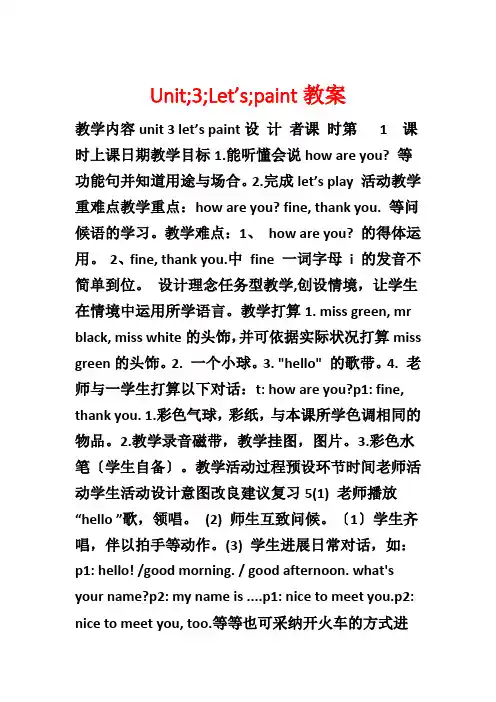
Unit;3;Let’s;paint教案教学内容unit 3 let’s paint设计者课时第1课时上课日期教学目标1.能听懂会说how are you? 等功能句并知道用途与场合。
2.完成let’s play 活动教学重难点教学重点:how are you? fine, thank you. 等问候语的学习。
教学难点:1、how are you? 的得体运用。
2、fine, thank you.中fine 一词字母i 的发音不简单到位。
设计理念任务型教学,创设情境,让学生在情境中运用所学语言。
教学打算1. miss green, mr black, miss white的头饰,并可依据实际状况打算miss green的头饰。
2. 一个小球。
3. "hello" 的歌带。
4. 老师与一学生打算以下对话:t: how are you?p1: fine, thank you. 1.彩色气球,彩纸,与本课所学色调相同的物品。
2.教学录音磁带,教学挂图,图片。
3.彩色水笔〔学生自备〕。
教学活动过程预设环节时间老师活动学生活动设计意图改良建议复习5(1) 老师播放“hello ”歌,领唱。
(2) 师生互致问候。
〔1〕学生齐唱,伴以拍手等动作。
(3) 学生进展日常对话,如:p1: hello! /good morning. / good afternoon. what's your name?p2: my name is ....p1: nice to meet you.p2: nice to meet you, too.等等也可采纳开火车的方式进展。
热身活动,让学生进入上课状态1. listen and do. (clap your hands.)2. t: write down oct. 31st on the bb. and say: it’s halloween. happy halloween! (make greetings with some students.)新授15(1) 老师举起miss white的头饰说:this is miss white.然后老师戴上miss white的头饰同学生打招呼: hello! good morning, boys and girls. i'm miss white. nice to meet you. 让学生说:nice to meet you, too. 用同样的方法介绍miss green和mr black.(2) 老师与两学生做示范表演。
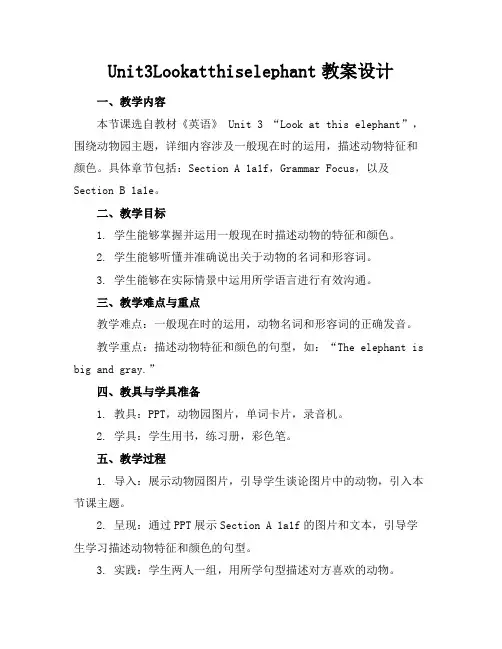
Unit3Lookatthiselephant教案设计一、教学内容本节课选自教材《英语》Unit 3 “Look at this elephant”,围绕动物园主题,详细内容涉及一般现在时的运用,描述动物特征和颜色。
具体章节包括:Section A 1a1f,Grammar Focus,以及Section B 1a1e。
二、教学目标1. 学生能够掌握并运用一般现在时描述动物的特征和颜色。
2. 学生能够听懂并准确说出关于动物的名词和形容词。
3. 学生能够在实际情景中运用所学语言进行有效沟通。
三、教学难点与重点教学难点:一般现在时的运用,动物名词和形容词的正确发音。
教学重点:描述动物特征和颜色的句型,如:“The elephant is big and gray.”四、教具与学具准备1. 教具:PPT,动物园图片,单词卡片,录音机。
2. 学具:学生用书,练习册,彩色笔。
五、教学过程1. 导入:展示动物园图片,引导学生谈论图片中的动物,引入本节课主题。
2. 呈现:通过PPT展示Section A 1a1f的图片和文本,引导学生学习描述动物特征和颜色的句型。
3. 实践:学生两人一组,用所学句型描述对方喜欢的动物。
4. 语法讲解:讲解一般现在时的用法,通过例句和练习进行巩固。
5. 例题讲解:选取Grammar Focus中的例题进行讲解,解释一般现在时的构成和用法。
6. 随堂练习:学生完成Section A 2a2f的练习,巩固所学知识。
8. 课堂互动:学生用所学语言进行角色扮演,模拟在动物园的场景。
六、板书设计1. Unit 3 Look at this elephant2. 重点句型:The elephant is big and gray. What color is it? It's white.3. 语法:一般现在时七、作业设计1. 作业题目:完成练习册Section A 2a2f。
2. 答案:见练习册。
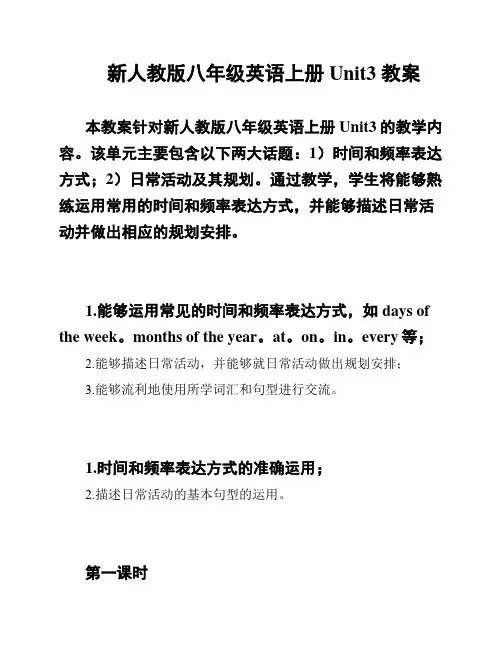
新人教版八年级英语上册Unit3 教案本教案针对新人教版八年级英语上册Unit3的教学内容。
该单元主要包含以下两大话题:1)时间和频率表达方式;2)日常活动及其规划。
通过教学,学生将能够熟练运用常用的时间和频率表达方式,并能够描述日常活动并做出相应的规划安排。
1.能够运用常见的时间和频率表达方式,如days of the week。
months of the year。
at。
on。
in。
every等;2.能够描述日常活动,并能够就日常活动做出规划安排;3.能够流利地使用所学词汇和句型进行交流。
1.时间和频率表达方式的准确运用;2.描述日常活动的基本句型的运用。
第一课时1.教授并练days of the week;2.学生进行日常活动的描述和规划。
1.复并巩固days of the week;2.教授并练months of the year;3.学生进行月份与日常活动的搭配练。
1.复并巩固days of the week和months of the year;2.教授并练at。
on。
in等时间表达方式;3.学生进行日常活动时间的描述练。
1.复并巩固时间表达方式;2.教授并练every的用法;3.学生进行日常活动规划的练。
1.情境教学法:通过创设真实的情境,让学生在实际生活中应用所学知识;2.合作研究法:通过小组合作研究,鼓励学生相互交流和合作,提高研究效果;3.游戏教学法:通过游戏形式激发学生的兴趣,提高研究积极性。
1.针对每一课时的研究内容,设计相应的练题进行评估;2.利用小组活动和教师提问的方式进行课堂实时评估;3.通过学生的作业和考试成绩,对研究效果进行总体评估。
1.教材:新人教版八年级英语上册Unit3;2.多媒体设备:投影仪、音响等;3.黑板和白板笔。
通过教材分析,我将采用情境教学法、合作研究法和游戏教学法等多种教学方法,来激发学生研究的兴趣,提高研究效果。
同时,将充分利用教学资源,使课堂内容更加生动有趣。
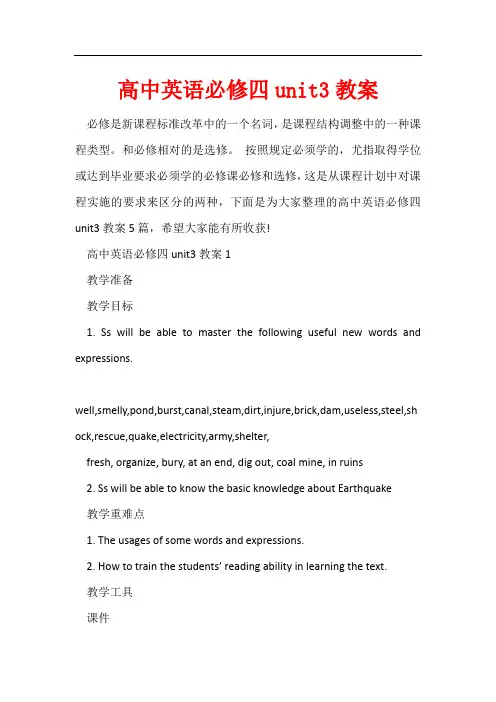
高中英语必修四unit3教案必修是新课程标准改革中的一个名词,是课程结构调整中的一种课程类型。
和必修相对的是选修。
按照规定必须学的,尤指取得学位或达到毕业要求必须学的必修课必修和选修,这是从课程计划中对课程实施的要求来区分的两种,下面是为大家整理的高中英语必修四unit3教案5篇,希望大家能有所收获!高中英语必修四unit3教案1教学准备教学目标1. Ss will be able to master the following useful new words and expressions.well,smelly,pond,burst,canal,steam,dirt,injure,brick,dam,useless,steel,sh ock,rescue,quake,electricity,army,shelter,fresh, organize, bury, at an end, dig out, coal mine, in ruins2. Ss will be able to know the basic knowledge about Earthquake教学重难点1. The usages of some words and expressions.2. How to train the students’ reading ability in learning the text.教学工具课件教学过程Step I lead-inLet students see a short video and answer the questions1.What happened in the video? Earthquakes2.How do you feel seeing the plots(情节)? Students’ discussion.Step II Fast reading1. What is the passage mainly about? In Tangshan ,earthquakes happened on July 28th 19762. Skim the text and answer the questionsThe type of writing (写作体裁)Narrative writingTopic sentence of Paragraph 1Sentence 1Topic sentence of Paragraph 2Sentence 2Topic sentence of Paragraph 3Sentence 1Topic sentence of Paragraph 4Sentence 1Step III Detailed readingAsk students to read the text carefully and answer the questions Task1: What were the nature signs of the coming earthquake?(选择)Para 11.Water in well( G )2. Well walls(D )3.Chickens pigs(F ) 4 .Mice (A)5.Fish(E )6. Bright lights( B)7. Water pipes(C )A. Ran out of fieldsB. in the skyC. Cracked and burstD. Deep cracksE. Jumped out of pondsF. Too nervous to eatG. Rose and fell, fell and roseTask 2 Fill in the blanksMain IdeaDetailsDamage caused byearthquakePara 2-3At _____ am, the __________ earthquake of the 20th century began . _______ burst from holes in the ground.Hard hills of the rock became rivers of ____.________ covered the ground like red autumn leaves.Two _______ and most of the bridges fell.The railway tracks were now _________pieces of _______.______ now filled the wells instead of water.Water,food,and ______________ were hard to get.The reconstruction(重建) after the earthquakePara 41. The army _____________2. Workers ____________for survivors.3._____________was taken to the city.Details:1. At 3:42 am, the greatest earthquake of the 20th century began.2. Steam burst from holes in the ground.3. Hard hills of the rock became rivers of dirt.4. Bricks covered the ground like red autumn leaves.5. Two dams and most of the bridges fell.6. The railway tracks were now useless pieces of steel.7. Sand now filled the wells instead of water.8. Water, food, and electricity were hard to get.Step IV consolidation (当堂巩固)Let students fill the blanks according to the passageStrange things were happening in the countryside of northeast Hebei. For three days the water in the village wells kept rising and 1_________(fall). Farmers noticed that the well walls had deep cracks 2___________ them. A smelly gas came out of the cracks. In 3_________farmyards, the chickens and even the pigs were too nervous 4__________(eat). 5_________(mouse) ran out of the fields looking for places 6________(hide). Fish jumped outOf their bowls and ponds. At about 3 am on July 28,1976, somepeople saw bright lights 7_________ the sky. The sound of planes could 8________(hear) outside the city of Tangshan even 9_________ no planes were in the sky.In the city, the water pipes in some buildings cracked and burst. But the one million people of the city, ________thought little of these events, were asleep as usual that night.1 falling2 in3 the4 to eat5 mice6 to hide 7in 8 be heard 9when 10 who这部分目的是让学生进一步巩固课文的内容。
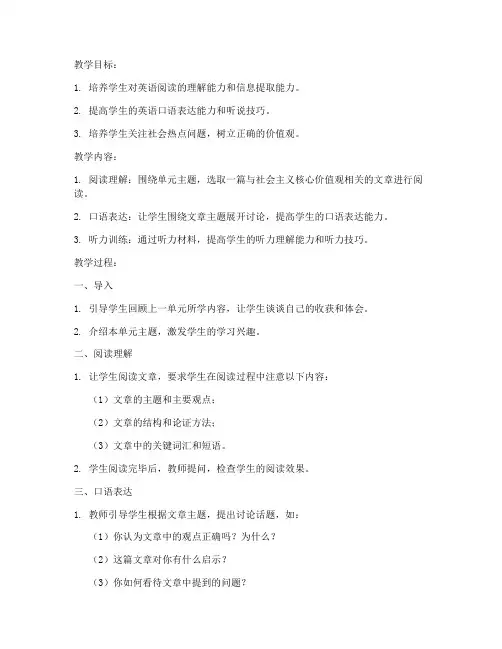
教学目标:1. 培养学生对英语阅读的理解能力和信息提取能力。
2. 提高学生的英语口语表达能力和听说技巧。
3. 培养学生关注社会热点问题,树立正确的价值观。
教学内容:1. 阅读理解:围绕单元主题,选取一篇与社会主义核心价值观相关的文章进行阅读。
2. 口语表达:让学生围绕文章主题展开讨论,提高学生的口语表达能力。
3. 听力训练:通过听力材料,提高学生的听力理解能力和听力技巧。
教学过程:一、导入1. 引导学生回顾上一单元所学内容,让学生谈谈自己的收获和体会。
2. 介绍本单元主题,激发学生的学习兴趣。
二、阅读理解1. 让学生阅读文章,要求学生在阅读过程中注意以下内容:(1)文章的主题和主要观点;(2)文章的结构和论证方法;(3)文章中的关键词汇和短语。
2. 学生阅读完毕后,教师提问,检查学生的阅读效果。
三、口语表达1. 教师引导学生根据文章主题,提出讨论话题,如:(1)你认为文章中的观点正确吗?为什么?(2)这篇文章对你有什么启示?(3)你如何看待文章中提到的问题?2. 学生分组讨论,每组推选一名代表进行发言。
四、听力训练1. 教师播放听力材料,要求学生认真听并记录关键信息。
2. 学生回答听力问题,教师检查学生的听力理解能力。
五、总结与反思1. 教师总结本节课所学内容,强调重点和难点。
2. 学生谈谈自己的学习体会,分享学习心得。
教学资源:1. 教材:新时代明德大学英语综合教程32. 阅读材料:与社会主义核心价值观相关的文章3. 听力材料:与文章主题相关的听力材料教学评价:1. 学生对阅读材料、口语表达和听力训练的掌握程度。
2. 学生参与课堂活动的积极性和主动性。
3. 学生对社会主义核心价值观的理解和认同。
教学反思:1. 教师应根据学生的实际情况调整教学内容和方法,提高教学效果。
2. 注重培养学生的自主学习能力,引导学生主动参与课堂活动。
3. 关注学生的情感态度,激发学生的学习兴趣,提高学生的综合素质。
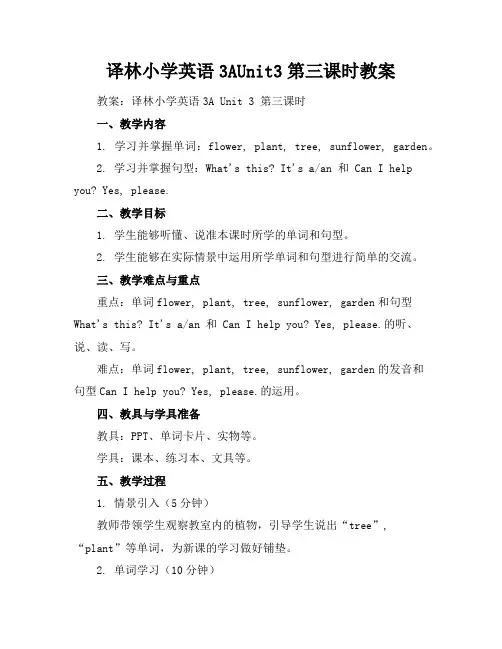
译林小学英语3AUnit3第三课时教案教案:译林小学英语3A Unit 3 第三课时一、教学内容1. 学习并掌握单词:flower, plant, tree, sunflower, garden。
2. 学习并掌握句型:What's this? It's a/an 和 Can I help you? Yes, please.二、教学目标1. 学生能够听懂、说准本课时所学的单词和句型。
2. 学生能够在实际情景中运用所学单词和句型进行简单的交流。
三、教学难点与重点重点:单词flower, plant, tree, sunflower, garden和句型What's this? It's a/an 和 Can I help you? Yes, please.的听、说、读、写。
难点:单词flower, plant, tree, sunflower, garden的发音和句型Can I help you? Yes, please.的运用。
四、教具与学具准备教具:PPT、单词卡片、实物等。
学具:课本、练习本、文具等。
五、教学过程1. 情景引入(5分钟)教师带领学生观察教室内的植物,引导学生说出“tree”, “plant”等单词,为新课的学习做好铺垫。
2. 单词学习(10分钟)(1)教师出示单词卡片,引导学生说出单词。
(2)学生跟读,注意单词的发音。
(3)教师举例说明单词的使用情景,帮助学生理解。
3. 句型学习(10分钟)(1)教师出示实物,引导学生用“What's this? It's a/an”进行问答。
(2)学生跟读,注意句型的运用。
(3)教师出示情景,引导学生用“Can I help you? Yes, please.”进行交流。
4. 课堂练习(10分钟)学生分组进行角色扮演,运用所学单词和句型进行对话。
教师巡回指导,纠正发音,提示表达。
5. 课堂小结(5分钟)教师带领学生回顾本节课所学单词和句型,巩固记忆。
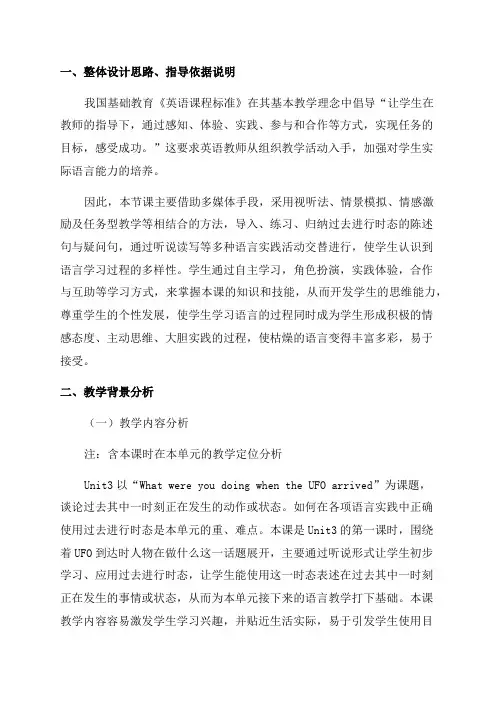
一、整体设计思路、指导依据说明我国基础教育《英语课程标准》在其基本教学理念中倡导“让学生在教师的指导下,通过感知、体验、实践、参与和合作等方式,实现任务的目标,感受成功。
”这要求英语教师从组织教学活动入手,加强对学生实际语言能力的培养。
因此,本节课主要借助多媒体手段,采用视听法、情景模拟、情感激励及任务型教学等相结合的方法,导入、练习、归纳过去进行时态的陈述句与疑问句,通过听说读写等多种语言实践活动交替进行,使学生认识到语言学习过程的多样性。
学生通过自主学习,角色扮演,实践体验,合作与互助等学习方式,来掌握本课的知识和技能,从而开发学生的思维能力,尊重学生的个性发展,使学生学习语言的过程同时成为学生形成积极的情感态度、主动思维、大胆实践的过程,使枯燥的语言变得丰富多彩,易于接受。
二、教学背景分析(一)教学内容分析注:含本课时在本单元的教学定位分析Unit3以“What were you doing when the UFO arrived”为课题,谈论过去其中一时刻正在发生的动作或状态。
如何在各项语言实践中正确使用过去进行时态是本单元的重、难点。
本课是Unit3的第一课时,围绕着UFO到达时人物在做什么这一话题展开,主要通过听说形式让学生初步学习、应用过去进行时态,让学生能使用这一时态表述在过去其中一时刻正在发生的事情或状态,从而为本单元接下来的语言教学打下基础。
本课教学内容容易激发学生学习兴趣,并贴近生活实际,易于引发学生使用目标语言进行简单的'交际与交流。
在学习活动中,通过观察***片、情景思维、俩俩对话,角色扮演等形式,使学生能够自主学习,合作交流,完成任务,培养学生的语言综合运用能力和实践能力。
(二)学生情况分析本课的主要目标是学习掌握过去进行时态的陈述句和疑问句,学会描述过去正在发生的事情或状态,它是在学生已经学习了现在进行时态和一般过去时态的基础上进行的。
对于八年级的学生来说,他们已经有了一定的词汇量,特别是对要用到的一些动词,大部分学生有了一定的基础,这样便于教学内容的突破。
人教版必修一第三单元Sports and Fitness-Living legends教学设计一、文本分析该部分的活动主题是“选择你最喜欢的运动员”。
某杂志请读者来信选出自己心目中的“体育界的活传奇”。
本文介绍了两个传奇人物郎平和乔丹。
这一中一外、一男一女不仅在体育方面取得了令人瞩目的成就,还有很多闪光的个人特质和魅力。
第一部分以独特的语言形式介绍了郎平,主要从人物功绩,面临困难,迎头而上,最终荣获奥运金牌。
第二篇介绍了“飞人”乔丹,主要从精湛的技巧,永不停止尝试的精神力量,乔丹本人坚守的信念,及其成功后乔丹分享成功等几个方面逐一介绍。
学生不仅崇拜他们,而且从这些模范身上学到了很多人生哲理。
重点词汇master, captain, determination, graceful, honor glory, failure, fall apart, lose heart, give up主要涉及体育传奇人物的身份、荣誉及其面临的困难时的态度。
本文的价值取向在于学生通过本文的学习,体会到“健康向上,不懈奋斗,团结协作”的体育精神,通过文本的梳理,人物的比对分析形成正确living legends 的评判标准。
旨在培养学生理性思考和客观评判的思维品质。
二、学情分析本班学生为高一.一班。
英语基础一般,学习态度端正。
学生刚刚开始进入高中学习,学习的积极性和热情都很高,但大多数学生获取细节信息的能力一般,只有部分学生能用英语表达。
在逻辑推理,分析比对,总结概括评价等方面的能力较欠缺。
此外学生虽然对体育话题比较熟悉,但是本文两个人物学生不是特别了解,尤其迈克尔乔丹在2003年已退役的。
学生对他们的新闻了解较少。
高一的学生从初中到高中的学习会遇到很多的挑战,这一话题在必修一第一单元中有所学习。
但面临如此多的挑战,如何解决困难呢?老师们在教学的过程中有所提及。
但本单元让他们通过榜样的力量让孩子们在学习生活中,养成不畏艰难,团结协作的精神,并积极乐观的生活。
Unit 3Section A: Fashion ForestTeaching Objectives:1.理解课文 A 和 B 的文章大意, 学习服装、发型等时尚元素, 了解对待时尚的正确态度。
2.理解和正确运用重点词汇、短语和句型 It is… that…;in +衣服/鞋/帽/颜色等;祈使句和反义疑问句。
3.掌握元音 /e/ 和 /eɪ/ 的不同发音。
4.学会正确使用动词(Part I)。
5.了解中国旗袍的发展历史。
Teaching Procedures:Part 1: Warm-up Activities1.Matching: Learn the following words and phrases about different clothing styles, and match them with the pictures.2.Listen to the conversation.Then practice with your partner, using the words and phrases provided on the right.Part 2: Text A: Fashion ForestⅠ.Background Information1.Pedro’s fablesThe collection consists of twenty-five children’s stories, in English, written by Pedro Pablo Sacristán.This timeless collection of short bedtime stories, fables, and fairy tales is entertaining and educational, with all sorts offunny and dramatic characters and situations.This is a great educational resource for parents and teachers.Ⅱ.Words and phrases1.e bypass 经过;路过She came by the house.她路过这栋房子。
五年级下册英语教案 - Unit 3 We should obey the rules.Lesson 16 人教精通版一、教学目标1.通过学习课文,学生能够掌握新单词praise、awesome、cheer等,并理解其在句子中的意义和运用方法;2.学生能够运用被动语态描述人们对不同习惯的看法,并掌握其构成方法;3.学生能够通过实践活动,理解遵守规则的重要性,积极参与班级规则制订并执行;4.学生能够通过阶段练习,掌握被动语态在句子中的正确使用。
二、教学重点1.新单词的掌握与运用;2.被动语态的构成和运用。
三、教学难点1.被动语态的正确使用;2.新单词的拼写和组合运用。
四、教学方法1.教师引导学生通过独立思考和讨论的方式,掌握新单词的意义和运用方法;2.教师通过示范和实践的方式,引导学生掌握被动语态的构成和运用;3.教师组织学生进行小组合作活动,让学生在实际操作中理解遵守规则的重要性。
五、教学过程1. Class Opening1.班长或任课老师与学生互动问候;2.根据实际情况开展开学典礼、早读、课堂常规讲解等。
2. Review1.教师向学生复习Unit 3中出现过的新单词,并让学生通过配对和填空的方式检查单词拼写和意义是否掌握;2.教师提问学生表示“遵守规则”有哪些英文表达方式,让学生从Unit 3中查找挖掘相关信息。
3. Presentation1.教师通过投影或黑板展示Lesson 16的文章The Rules of My Classroom,并引导学生朗读并注重语音和语调;2.教师让学生自己尝试翻译文章中的生词praise、awesome、cheer,并结合文章理解其含义和用法;3.教师向学生讲解被动语态的构成和运用方法,并让学生在文章中找出被动语态出现的句子,理解其语法结构和意义;4.教师就如何制定和执行班级规则与学生展开讨论,引导学生思考遵守规则的重要性并通过实践活动提高遵守规则的自觉性。
必修三unit3 教案教案标题:必修三 Unit 3 教案教案目标:1. 理解并掌握本单元的词汇和短语;2. 能够运用所学的语法知识正确使用被动语态;3. 能够运用所学的语言知识讨论和描述不同的城市。
教学重点:1. 词汇和短语的掌握;2. 被动语态的正确使用;3. 城市的描述和讨论。
教学难点:1. 被动语态的正确使用;2. 城市的描述和讨论。
教学准备:1. 多媒体设备;2. 单词卡片和图片;3. 板书工具。
教学过程:Step 1: 导入(5分钟)1. 通过展示一些城市的图片,引起学生对城市的兴趣,激发学生的学习欲望。
2. 引导学生讨论自己喜欢的城市和不喜欢的城市,鼓励他们用英语表达自己的观点。
Step 2: 词汇和短语学习(15分钟)1. 分发单词卡片,让学生阅读并尝试发音。
2. 通过图片或实物展示,解释单词的意思。
3. 引导学生进行词汇和短语的搭配练习,例如:“traffic jam”,“skyscraper”等。
Step 3: 语法学习(20分钟)1. 通过多媒体展示被动语态的用法和结构,并解释其基本规则。
2. 给学生提供一些例句,让他们尝试将主动语态转换为被动语态。
3. 给学生一些练习题,让他们巩固被动语态的用法。
Step 4: 阅读和讨论(20分钟)1. 分发阅读材料,让学生阅读有关不同城市的文章。
2. 引导学生进行小组讨论,让他们分享自己对不同城市的看法和观点。
3. 鼓励学生使用被动语态和所学的词汇和短语来描述和讨论城市。
Step 5: 总结和作业布置(5分钟)1. 总结本节课所学的内容,强调被动语态的正确使用和城市描述的技巧。
2. 布置作业:要求学生写一篇关于自己所在城市的短文,使用被动语态和所学的词汇和短语进行描述。
教学反思:通过本节课的教学,学生能够掌握本单元的词汇和短语,理解并正确使用被动语态,能够用英语进行城市的描述和讨论。
同时,通过小组讨论和写作作业,学生的口语和写作能力也得到了提高。
三年级英语上册《Unit 3 Look at me!》教案优质范文一、教学目标1.学生能够掌握身体器官的名称:eyes, nose, mouth, ears, hand, foot。
2.学生能够听懂、会说并正确运用以下句型:•Look at my…(eyes/nose/mouth/ears/hand/foot)•What do you see?•I see…(eyes/nose/mouth/ears/hand/foot)二、教学重点难点1.教学重点:让学生掌握身体器官的名称及句型Look at my…和I see…。
2.教学难点:如何提高学生在教学中的积极参与性和口语表达能力。
三、教学准备1.教师准备:课件、图片、小礼物。
2.学生准备:学习工具、课堂参与度高。
四、教学过程1.热身用图片向学生介绍body parts的名称,让学生跟读。
2.引入老师带着学生一起说:Look at me! 然后问:What do you see? 让学生用眼睛观察老师,注意细节,然后回答:I see…(eyes/nose/mouth/ears/hand/foot)。
3.核心关键内容1.教师出示图片,通过问Look at my…及I see…帮助学生掌握身体器官的名称,并教授相关单词。
2.教师让学生参与游戏。
让学生把自己的身体部位张开,让其他同学说出这些器官的名称。
3.讲解句型Look at my…和I see…的用法。
老师会利用这两个句型让学生自己猜测并描述自己的身体器官。
4.为了检测学生的理解能力,让学生证明自己已经会说这些单词,找到相关部位并说出来。
4.巩固1.教师参考教材《Unit 3 Look at me!》中的图片,让学生用所学单词来描述人体。
2.教师让学生寻找身边人的不同之处,并描述这些差异。
5.作业教师可以布置一些相关拼写和发音练习作业。
6.总结反思教师让学生分享今天学到的知识点,概括今天的教学内容,以及自己的收获与感悟。
Unit 3 How much is it?一、学情分析本班为高一专业班。
根据调查,本班学生多数来自民工子弟学校,英语基础非常薄弱,部分学生由于学习兴趣不浓,学习主动性不够。
更多学生的学习惰性较强,所以,当务之急是要激发全体学生学习兴趣,唤起他们的自尊、自信,培养他们的语言综合运用能力。
为了调动课堂气氛,吸引学生,在教学设计中我充分利用直观教具和电化教学手段,利用多媒体课件教学,创设真实情境,力求帮助学生在真实语境中掌握词汇,培养他们运用并解决实际问题的能力,从而在课堂上体现出英语教学的实用性的特点。
二、教材分析本课时系教材《英语1》(基础模块高教版)第三单元的第二课时,是Listening and speaking中的Dialogue B,内容包括:部分常用商品和常见购物场所的词汇、买卖商品活动中展开的对话,以及关于商品信息的词汇。
这些内容是整个单元学听说课的重点,为学生学以致用的语言表达活动提供了语言铺垫。
因为购物是一个与我们生活密切相关的话题,这有助于吸引学生的学习兴趣,帮助学生积极开展英语日常会话。
三、教学目标1. 知识目标⑴帮助学生复习并运用上节课学的商品及购物场所的单词。
如bakery,supermarket。
⑵学生能掌握购物双方所使用的基本句型,如:What can I do for you?I’d like to buy….How much is the cake?Two yuan a kilo.I’ll take….(3)使学生理解关于商品信息的词汇,如:quality,unit price,amount,signiture。
2. 能力目标⑴通过听力与朗读提高学生听说能力;⑵通过学习购物常用句型提高学生英语交际口语能力。
3. 情感目标引导学生热爱生活,积极投入社会,享受沟通乐趣。
同时有意地培养学生团队合作意识。
4.教学重点、难点⑴教学重点通过学习顾客与售货员之间的对话,学生能顺利进行商品买卖活动,并理解商品基本信息。
⑵教学难点学生运用提高听力效果的策略——以表格形式记录关键信息,理解购物发票各项目的含义。
四、教学步骤Step One Lead-in (9min)1. Movie show (6min)Teacher shows a short movie about shopping in a big shopping mall. Then the teacher ask students to answer these questions:What is she doing?Where is she now?What did she buy just now?Do you think all the goods she bought is useful or not?(设计意图:用购物视频来引入新课,同时复习上节课所学知识帮助教师一下子将学生引入真实购物场所。
同时教师应及时引导学生此类购物现象是不可取的。
)2. Brainstorming (3min)Teacher says, “Yes, most of the goods she bought is useless and it’s really a waste of money. So before buying something, what information of the goods will you always pay attention to? That means what items should you consider?”Studens give different opinions(Chinese is ok.), such as: 价格、质量、生产日期。
(设计意图:让学生展开想象,自然引入生词---item. 由item 过渡到quantity, unit price, amount等本课重点词汇。
按照本班实际情况设想,学生的回答大多为中文,让他们产生迫切希望知道相关的英语的欲望能激发他们的学习主动性。
)Step Two Listening (Activity 7, 8) (10 min)1. Activity 7. Listen and tick. (5 min)Teacher says, “Jerry is my friend, she always goes to the supermarket to buy something. Usually she will buy the goods.(Showing pictures) Can you name them?”Then the teacher asks the students to read the words together, paying attention to the pronunciation.The the teacher says, “Unluckily, some goods is sold out. What’s it?Listen to the tape carefully and tick the goods that is sold out.(设计意图:本班学生听力能力很差,教师先让学生一起用英语说出图片中的物体,这能降低听力的难度。
图片的直观性还能帮助学生更容易记住单词。
)2. Activity 8. Listen and complete. (5 min)Teacher says, “Now Jerry can only buy pizza and cake, right? But she is very busy now, can you help her?”Students listen to the dialogue and finish the invoice individually. Then the whole class check the answers together.Teacher introduces a tip on how to make the listening activity more efficient: Write down the key words of a dialogue in a form.Listen again if necessary.(设计意图:该步骤旨在唤醒学生乐于助人的精神,让他们主动投入到听力训练中。
教师对于听力策略的提醒,能帮助学生形成科学高效的学习方法。
)Step Three Speaking (Activity 9 , 10, 11) (20min)1. Read and filling the blanks. (3 min)Students read the dialogue in Activity 9 individually, then ask the students to devide the dialogue into 2 groups, and the teacher writes down the sentences on the blackboard:Customer( )Salesperson(设计意图:学生通过阅读,分别找出Activity 9中买卖双方的对话很简单。
通过表格的形式让学生对关键句型的印象更加深刻,同时也为后面语言综合运用活动的展开打下基础。
)2.Read the dialogue. (3min)Students read the dialogue aloud together.Students practice reading the dialogue with their deskmates.Then ask several pairs to read the dialogue.(设计意图:各种方式的朗读能帮助学生加深对购物中买卖语句的印象。
在朗读时,教师应注意学生的发音,对于个别错误较多的发音再单独拎出来进一步进行纠正。
)3. Game: Role-play (10 min)(1)Teacher give students several minutes to think about more sentences which can be used in buying and selling goods.(2)Teacher asks students to close their books and writes some important sentences used by customers on the blackboard to help the students.(3)Then the teacher acts as a salesperson, stuedents are made to be customers. (teacher had better prepare some goods before class, and the teacher’s desk can be used as a counter.) The whole class are asked to vote a best customer who will get a small gift.(4)Volunteer students asked to be a salesperson. Then let stuendents to choose the best salespeson, and also he will receive a small gift.(设计意图:发散思维帮助学生复习以前所学知识。
角色扮演能帮助学生进一步巩固掌握购物所用语句。
最佳消费者\最佳售货员的评选更有利于激发学生的热情,将课堂气氛推入高潮。
这些重点语句的熟练运用就是本课的最终成果。
)4. Group Discussion: How to successfully sell your goods? (4 min)Students has already experienced selling things. Now they are devided into groups to discuss what factors are important during selling the products.Then each group are told to give their conclusion.(设计意图:该步骤的活动和学生生活密切相关,有助于学生发散思维,将话题引入真实生活情境。